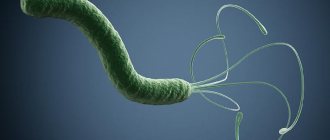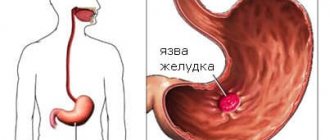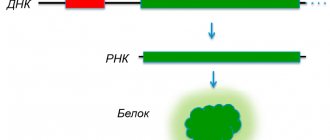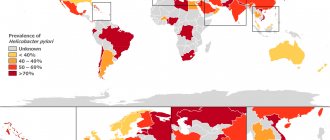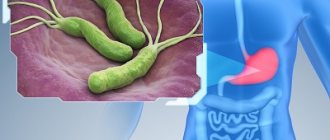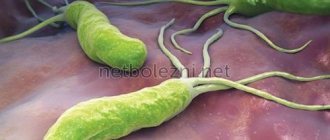Just some 30–40 years ago, the diagnosis of gastric ulcer knocked the ground out from under our feet. A lifelong diet and endless treatment for an ulcer, which, despite all the doctors’ tricks, felt great in the stomach and was not going to heal. Today a solution has been found. The triumphant discovery, which became the key to the solution to peptic ulcer disease, still gives scientists confidence. And most importantly, it gives hope to thousands of people who are waiting for new drugs for cancer, AIDS and many other serious diseases.
CC dossier
Marina Pozdeeva
City Dnepropetrovsk
First category pharmacist and pharmacy manager. Author of numerous works on pharmacology and pharmacotherapy
Peptic ulcer disease in the world of big numbers
According to various sources, from 10 to 15% of the world's population will experience this disease at some point in their lives. Both in Russia and throughout the world, peptic ulcer disease is considered the most common gastrointestinal pathology, and with age the likelihood of getting sick becomes higher. This is largely due to the fact that the risk of “catching” the culprit of all troubles - small, but very resistant in an acidic environment, Helicobacter pylori - only grows over the years. And if at the age of 20 the probability of infection is 20%, then with each subsequent decade it increases by exactly 10%. It turns out that by the beginning of their sixties, half of the planet’s inhabitants are already intimately familiar with H. pylori.
Every year more and more new cases of the disease are diagnosed. Doctors attribute this disappointing trend to the widespread use of non-steroidal anti-inflammatory drugs, which significantly increase the vulnerability of the stomach wall. However, the achievements of modern medicine make it possible to give a very favorable prognosis for peptic ulcer disease. But back at the end of the last century, everything was not so clear.
Table 1.
Eradication therapy regimens
| A drug | Dose | Frequency of application |
| 1st line eradication therapy (7–10 days) | ||
| IPP | standard dose | 2 times a day |
| clarithromycin | 500 mg | |
| amoxicillin | 1g | |
| 2nd line therapy (10–14 days) - if first line therapy is ineffective or intolerant | ||
| IPP | standard dose | 2 times a day |
| metronidazole or amoxicillin | 500 mg (amoxicillin - 1 g) | 3 times a day (amoxicillin 2 times a day) |
| tetracycline | 500 mg | 4 times a day |
| bismuth drug | 120 mg | |
Routes of infection
Helicobacter pylori enters the child's body through the fecal-oral route. Children's hygiene skills are not fully developed, so it is not difficult for them to become infected.
Possible routes of infection of a child with Helicobacter pylori:
- Through contaminated water.
- Through contaminated food, for example, by eating unwashed fruits or berries.
- Through expired food.
- If hygiene measures are not observed.
The weaker a child's gastrointestinal tract, the higher the likelihood of developing an infection. The state of the digestive system is negatively affected by eating fast food and the absence of liquid dishes on the menu.
It is extremely rare that infection occurs iatrogenically, when non-sterile instruments are used in the clinic during diagnosis.
The risk of infection of the child from other family members is high. If at least one person is a carrier of Helicobacter pylori, then the risk of transmitting the bacteria to people living with him in the same apartment is equal to 95%.
A child can be infected not only at home, but also at school or kindergarten. It is enough to not wash your hands once after a walk for harmful bacteria to enter the body. Moreover, at a young age, children put everything in their mouths, from toys to their fingers. Be sure to teach your child to wash their hands after visiting the restroom.
Trial and error
For many years, the origin of peptic ulcer disease was interpreted incorrectly. False theories became a strong basis for erroneous treatment that did not bring the expected results. At the beginning of the 20th century, doctors were inclined to believe that a person pays for nervous shock with a stomach ulcer. The basis of therapy was a diet excluding everything fried, hot and spicy, and, of course, sedatives. It is not surprising that against the background of such treatment, recovery was a very doubtful outcome.
A little later, the unfortunate hydrochloric acid begins to be blamed for the occurrence of peptic ulcers. She and only she is declared the root cause of the disease. Appropriate adjustments are made to the usual treatment regimen: antacids become the basis of antiulcer therapy. These drugs undoubtedly alleviated the course of the peptic ulcer, but they could not guarantee a complete cure. Temporary remission that occurred after a course of eradication therapy with antacids, as a rule, ended in relapse. And only in the early 80s did the long-awaited truth, suffered by millions of patients, dawn.
Stock
Specialist. price!
Benefits for families with many children, pensioners and disabled people - for an appointment with Voll diagnostics!
Happy birthday!
7 days before and after your holiday! Gift – Minus 500 RUR!
As a gift - 500 rubles!
By completing the survey, you save RUR 500!
The material was prepared with the participation of homeopathic doctor Tatyana Vladimirovna Valyasina. You can find out more about the author at this link.
Discovery of Helicobacter pylori
The history of one of the greatest discoveries of the 20th century began in 1979, when ordinary doctor Barry Marshall received a position at the largest clinic in Western Australia - the Royal Perth Hospital. During one of the internal trainings organized by the clinic's management, Marshall met the talented pathologist Robin Warren. He was just studying the etiology of gastritis and managed to captivate his new friend. Already in 1981, the duo of Marshall and Warren discovered a spiral bacterium in the mucous membrane of patients with gastritis. It took researchers a year to develop a hypothesis linking the “newborn” Helicobacter pylori with strong ties to peptic ulcers and stomach cancer.
However, the road to success is rarely paved with roses and lilies. At first, the theory of Marshall and Warren met only grins from colleagues and skepticism from venerable scientists. In 1998, when the difficulties were over, Marshall wrote: “Everyone was against me then. But I knew I was right." Persistent Australians paved the way for their discovery, sparing neither time, nor strength, nor health.
After an unsuccessful attempt to infect piglets with Helicobacter pylori infection, Marshall decided on an experiment worthy of great researchers. He drank the contents of the Petri dish in which H. pylori was cultured and prepared to wait. The scientist hoped that in a year or a little more he would be diagnosed with a stomach ulcer, and he would finally prove an obvious cause-and-effect relationship. However, events were not long in coming.
Three days into the experiment, Marshall's mother noticed that her son's breath began to smell bad. Soon nausea and vomiting joined the symptoms, and just eight days after the desperate act, an endoscopic examination confirmed: acute gastritis had begun in the doctor’s stomach, and H. pylori was cultured from a smear of the mucous membrane. On the 14th day of the experiment, Marshall began taking antibiotics. After the course of treatment, complete recovery was recorded.
In 1985, details of the experiment appeared in the pages of the Medical Journal of Australia. By the way, this article soon gained worldwide fame and became the most cited in the entire history of the publication. It would seem that the evidence is obvious and the matter is small. However, full recognition was still almost a decade away.
Table 2.
Drugs for eradication therapy (international and trade names)
| Group | International name | Tradename |
| antibiotics penicillins | amoxicillin | Ospamox, Flemoxin Solutab, Hiconcil |
| macrolide antibiotics | clarithromycin | Labax, Klabax OD, Clarithromycin-Zentiva, Clarithromycin Pfizer, Klacid, Klacid SR, Fromilid, Fromilid Uno |
| antibiotics tetracyclines | tetracycline | Tetracycline |
| proton pump inhibitors | omeprazole | Zerotsid, Losek, Omez, Omizak, Ortanol, Romesek, Ulkozol, Ultop, Helitsid, Cisagast |
| lansoprazole | Lanzabel, Lanzap, Lanzoptol, Lancid, Loenzar-sanovel, Epicurus | |
| rabeprazole | Bereta, Zolispan, Zulbex, Noflux, Ontime, Pariet, Rabelok, Hayrabezol | |
| pantoprazole | Zipantola, Controloc, Crosacid, Nolpaza, Pantaz, Panum, Peptazol, Pigenum-sanovel, Puloref, Sanpraz, Ulthera | |
| esomeprazole | Nexium, Neo-Zext, Emanera | |
| antimicrobial and antiprotozoal agents | metronidazole | Klion, Metrogyl, Metronidazole, Trichopolum, Flagyl, Efloran |
| gastroprotectors | bismuth tripotassium dicitrate | De-Nol, Novobismol |
Reviews
Alesya
38 years
I was treated with antibiotics for Helicobacter. It turns out that the doctor didn’t even know any other treatment! I didn’t want to take chemo - I started studying reviews. I read about Professor Voronkov’s excellent results. He didn’t prescribe anything other than homeopathy! Over the course of a week, my pain and nausea gradually stopped. Laboratory tests have become much better. The main thing is that I feel almost normal. Now I continue treatment for my gallbladder and pancreas. On my advice, two more of my friends went to him - they were also quite happy!
Michael
38 years
Andrey Anatolyevich cured me of Helicobacter. Before seeing him, I took antibiotics several times. But in vain - the disease returned! A couple of months later the complaints appeared again. Probably, my immunity was low - there was no protection against this bacterium. After undergoing treatment with Dr. Voronkov, I have been feeling good for more than a year! Andrei Anatolyevich emphasized: the main thing is not only to recover, but also not to become infected again! I regret that I didn’t know about homeopathy earlier!
The fight for recognition
It was not until 1994 that the US National Institutes of Health documented the close association between H. pylori and peptic ulcers and recommended treating it with antibiotics. However, in 1995, most patients with stomach ulcers were still receiving antisecretory therapy, and only 5% of the lucky ones met doctors who prescribed antibiotics.
In the same 1995, the American Health Foundation conducted a large survey among people suffering from peptic ulcers. The results were impressive. More than 10 years after the discovery of H. pylori, 90% of patients had no idea that the true cause of their illness was an infection and blamed stress and weak nerves.
In 1996, the American Drug Administration (FDA) approved the use of an antibiotic for the treatment of peptic ulcers for the first time in the world. A year later, in the same United States, a national campaign was launched, the purpose of which was to inform doctors and pharmacists about the connection between gastric ulcers and H. pylori. Soon the news of the absolute curability of the previously quite serious disease spread throughout countries, cities and villages, and a new era in the treatment of peptic ulcer disease began.
Table 3.
Combination drugs for eradication therapy
| International name | Tradename |
| omeprazole+amoxicillin+clarithromycin | Pilobact AM |
| lansoprazole+amoxicillin+clarithromycin | Lancid Keith, Helitrix |
What about the discoverers? They fully felt the sweet burden of glory and continue to bask in its rays to this day. In 2005, at the Karolinska Institute in Stockholm, Marshall and Robin William received the most prestigious prize, which has been awarded for more than 100 years for outstanding achievements in science and culture. The gold medal, accompanied by a diploma from the Nobel Committee and a very substantial monetary reward, was awarded to Australian scientists for “the discovery of the bacterium Helicobacter pylori and its role in the development of gastritis and peptic ulcers.” And eradication therapy, which began back in 1982, continues to save millions of patients, curing ulcers and preventing cancer.
Preparations for Helicobacter pylori eradication
Today, several regimens for Helicobacter pylori eradication therapy have been developed, which are selected individually.
The traditional anti-Helicobacter complex includes: an antibiotic (amoxicillin, clarithromycin or tetracycline); proton pump inhibitor; metronidazole; bismuth preparations.
Amoxicillin
The penicillin antibiotic, amoxicillin, is very close to ampicillin both structurally and in its spectrum of activity. Amoxicillin is stable in an acidic environment. The drug inhibits the synthesis of bacterial cell walls and acts both locally and systemically after absorption into the bloodstream and subsequent penetration into the lumen of the stomach. H. pylori demonstrates good sensitivity to amoxicillin in vitro, but complex therapy is required to eradicate the bacterium.
Clarithromycin
Clarithromycin, a 14-member macrolide, is a derivative of erythromycin with a similar spectrum of activity and indications for use. However, unlike erythromycin, it is more acid resistant and has a longer half-life. The results of studies showing that a triple anti-Helicobacter therapy regimen using clarithromycin gives a positive result in 90% of cases has led to the widespread use of the antibiotic. In this regard, an increase in the prevalence of clarithromycin-resistant strains of H. pylori has been recorded in recent years.
Tetracyclines
The point of application of tetracyclines is the bacterial ribosome. The antibiotic interrupts protein biosynthesis and specifically binds to the 30S ribosomal subunit, eliminating the addition of amino acids to the growing peptide chain. Tetracycline has been shown to be effective in vitro against H. pylori and remains active at low pH.
Proton pump inhibitors (PPIs)
PPI therapy has proven effective in various clinical studies. It is assumed that antisecretory drugs of the PPI group may help increase the concentration of antimicrobial agents, in particular metronidazole and clarithromycin, in the gastric lumen. PPIs reduce the volume of gastric juice, as a result of which the leaching of antibiotics from the surface of the mucosa decreases and the concentration, accordingly, increases. In addition, reducing the volume of hydrochloric acid maintains the stability of antimicrobials. Different PPIs do not differ in effectiveness.
Metronidazole
H. pylori is generally very sensitive to metronidazole, the effectiveness of which is independent of pH. After oral or infusion use, high concentrations of the drug are achieved in the gastric juice, which makes it possible to achieve the maximum therapeutic effect. Metronidazole causes H. pylori to lose its helical DNA structure, causing DNA damage and killing the bacterium.
Bismuth preparations
Bismuth was one of the first drugs to eradicate H. pylori. There is evidence that bismuth has a direct bactericidal effect, although its minimum inhibitory concentration (MIC - the smallest amount of drug that inhibits the growth of a pathogen) against H. pylori is too high. Like other heavy metals such as zinc and nickel, bismuth compounds reduce the activity of the enzyme urease, which is involved in the life cycle of H. pylori. In addition, bismuth preparations have local antimicrobial activity, acting directly on the bacterial cell wall and disrupting its integrity.
Diagnostics
When the first symptoms of a child becoming infected with Helicobacter pylori appear, you should consult a specialist. First you need to visit a pediatrician. If suspicions are confirmed, then it is necessary to undergo treatment under the supervision of a pediatric gastroenterologist.
A preliminary diagnosis can be made even based on the mother’s complaints and on the basis of an examination of the child. Antibodies to Helicobacter pylori can be detected in the blood and stool. Therefore, it will be necessary to submit these materials for research.
Using an endoscope, the doctor examines the gastric mucosa and assesses the degree of damage. During the study, it is possible to take a biopsy of the coolant, which is subjected to laboratory tests and Helicobacter pylori is detected in it.
Non-invasive methods include a breath test, when a conclusion about the presence of bacteria in a child’s body is made based on a study of exhaled air. Children are recommended to undergo a breathing “Helic test”, during which the child will need to drink a solution of urea. This substance does not pose any threat to the baby’s health, so the study is absolutely safe.
Modern medicine also has molecular methods for detecting Helicobacter pylori. To carry it out, dental plaque is taken from the subject.
To make a diagnosis, a comprehensive examination is required.
Guarantees of effectiveness - in the hands of the pharmacist?
The effectiveness of eradication therapy has been calculated and sorted out. First-line therapy is successful in more than 75% of cases, and treatment using an alternative regimen (second line) brings recovery to 93% of patients. The unsatisfactory result of treatment is explained simply: bacteria quickly adapt to antibiotics and new, resistant strains appear. To defeat H. pylori, you must strictly follow the treatment regimen. And an undisciplined patient trying to replace, cancel or delay taking one or even several components of eradication therapy should be aware of the danger that awaits him.
A pharmacist and pharmacist can tell a doubting client how many additional problems may befall him when trying to “improve” the anti-ulcer complex in his own way. Don't skimp on colors when your customer wants to turn off the straight road to recovery towards traditional medicine or homeopathy. Paint a picture of resistant Helicobacter pylori infection brightly and on a grand scale, and another good deed will appear on your account.
How to treat Helicobacter pylori?
Diagnosis of Helicobacter: blood test
The bacterium Helicobacter pylori is a very living microorganism that is able to survive in acidic conditions, has a disgusting effect on the human immune system, namely, it blocks the ability of white blood cells (leukocytes) to destroy harmful living organisms. And in order to recover from this parasite, it is necessary to undergo a course of antibacterial therapy.
The process of destroying these bacteria in the body has its own name - “eradication”, and consists of several schemes. During treatment, different medications belonging to different groups of action are prescribed. Antibacterial treatment has three lines, which we will tell you about.
